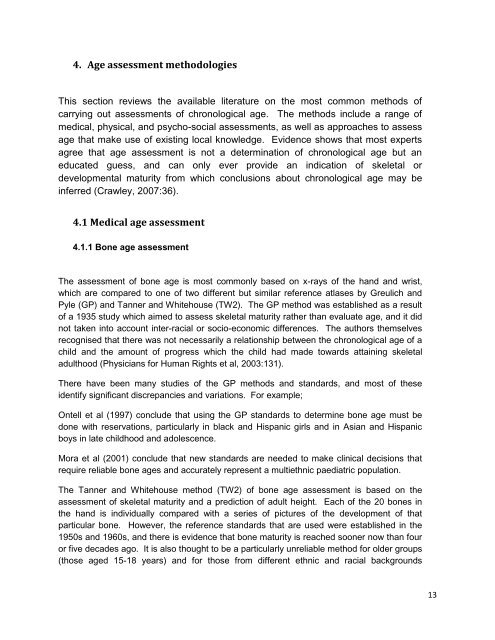Age assessment practices: a literature review & annotated ... - Unicef
Age assessment practices: a literature review & annotated ... - Unicef
Age assessment practices: a literature review & annotated ... - Unicef
Create successful ePaper yourself
Turn your PDF publications into a flip-book with our unique Google optimized e-Paper software.
4. <strong>Age</strong> <strong>assessment</strong> methodologies<br />
This section <strong>review</strong>s the available <strong>literature</strong> on the most common methods of<br />
carrying out <strong>assessment</strong>s of chronological age. The methods include a range of<br />
medical, physical, and psycho-social <strong>assessment</strong>s, as well as approaches to assess<br />
age that make use of existing local knowledge. Evidence shows that most experts<br />
agree that age <strong>assessment</strong> is not a determination of chronological age but an<br />
educated guess, and can only ever provide an indication of skeletal or<br />
developmental maturity from which conclusions about chronological age may be<br />
inferred (Crawley, 2007:36).<br />
4.1 Medical age <strong>assessment</strong><br />
4.1.1 Bone age <strong>assessment</strong><br />
The <strong>assessment</strong> of bone age is most commonly based on x-rays of the hand and wrist,<br />
which are compared to one of two different but similar reference atlases by Greulich and<br />
Pyle (GP) and Tanner and Whitehouse (TW2). The GP method was established as a result<br />
of a 1935 study which aimed to assess skeletal maturity rather than evaluate age, and it did<br />
not taken into account inter-racial or socio-economic differences. The authors themselves<br />
recognised that there was not necessarily a relationship between the chronological age of a<br />
child and the amount of progress which the child had made towards attaining skeletal<br />
adulthood (Physicians for Human Rights et al, 2003:131).<br />
There have been many studies of the GP methods and standards, and most of these<br />
identify significant discrepancies and variations. For example;<br />
Ontell et al (1997) conclude that using the GP standards to determine bone age must be<br />
done with reservations, particularly in black and Hispanic girls and in Asian and Hispanic<br />
boys in late childhood and adolescence.<br />
Mora et al (2001) conclude that new standards are needed to make clinical decisions that<br />
require reliable bone ages and accurately represent a multiethnic paediatric population.<br />
The Tanner and Whitehouse method (TW2) of bone age <strong>assessment</strong> is based on the<br />
<strong>assessment</strong> of skeletal maturity and a prediction of adult height. Each of the 20 bones in<br />
the hand is individually compared with a series of pictures of the development of that<br />
particular bone. However, the reference standards that are used were established in the<br />
1950s and 1960s, and there is evidence that bone maturity is reached sooner now than four<br />
or five decades ago. It is also thought to be a particularly unreliable method for older groups<br />
(those aged 15-18 years) and for those from different ethnic and racial backgrounds<br />
13
















